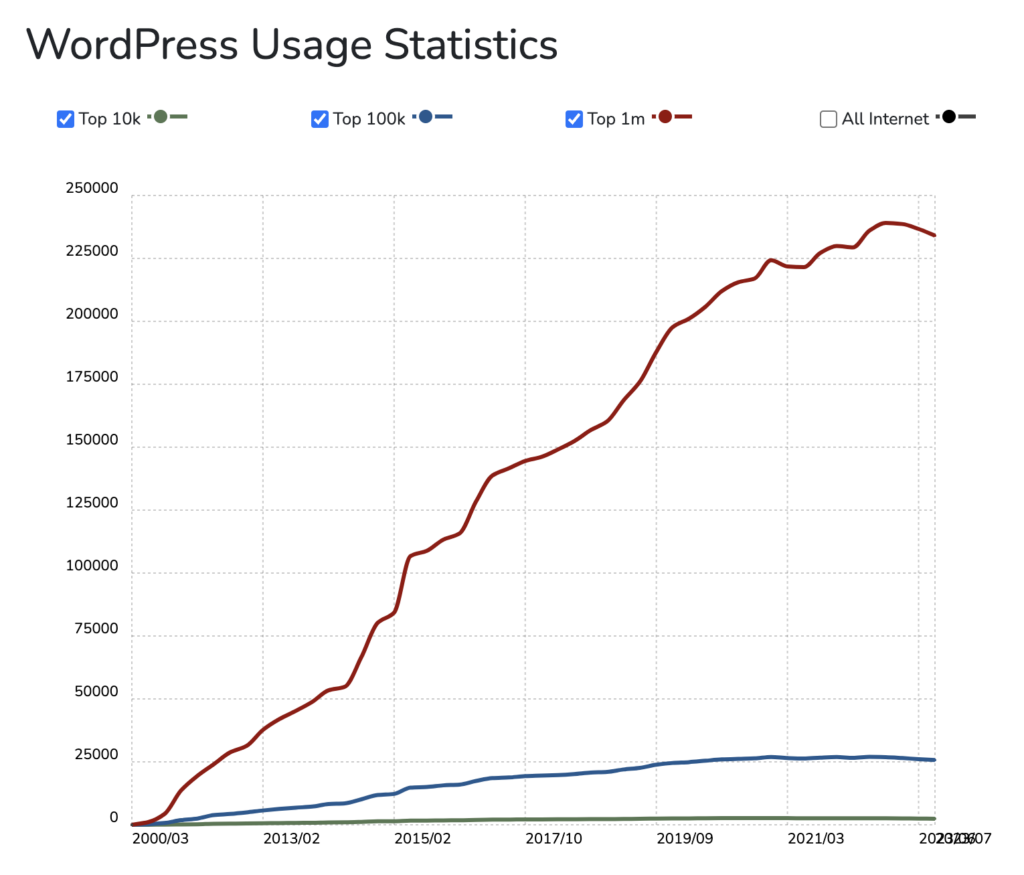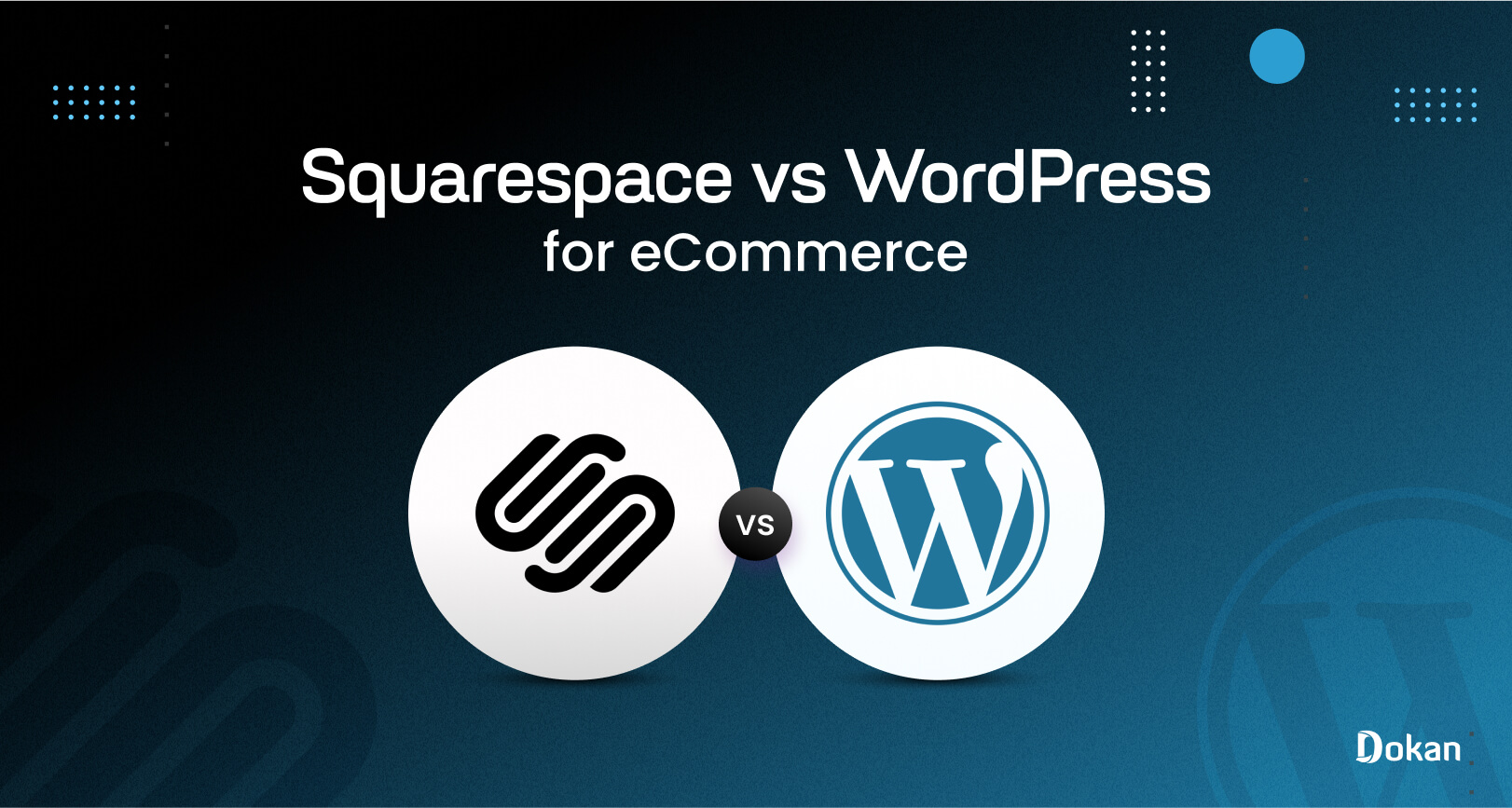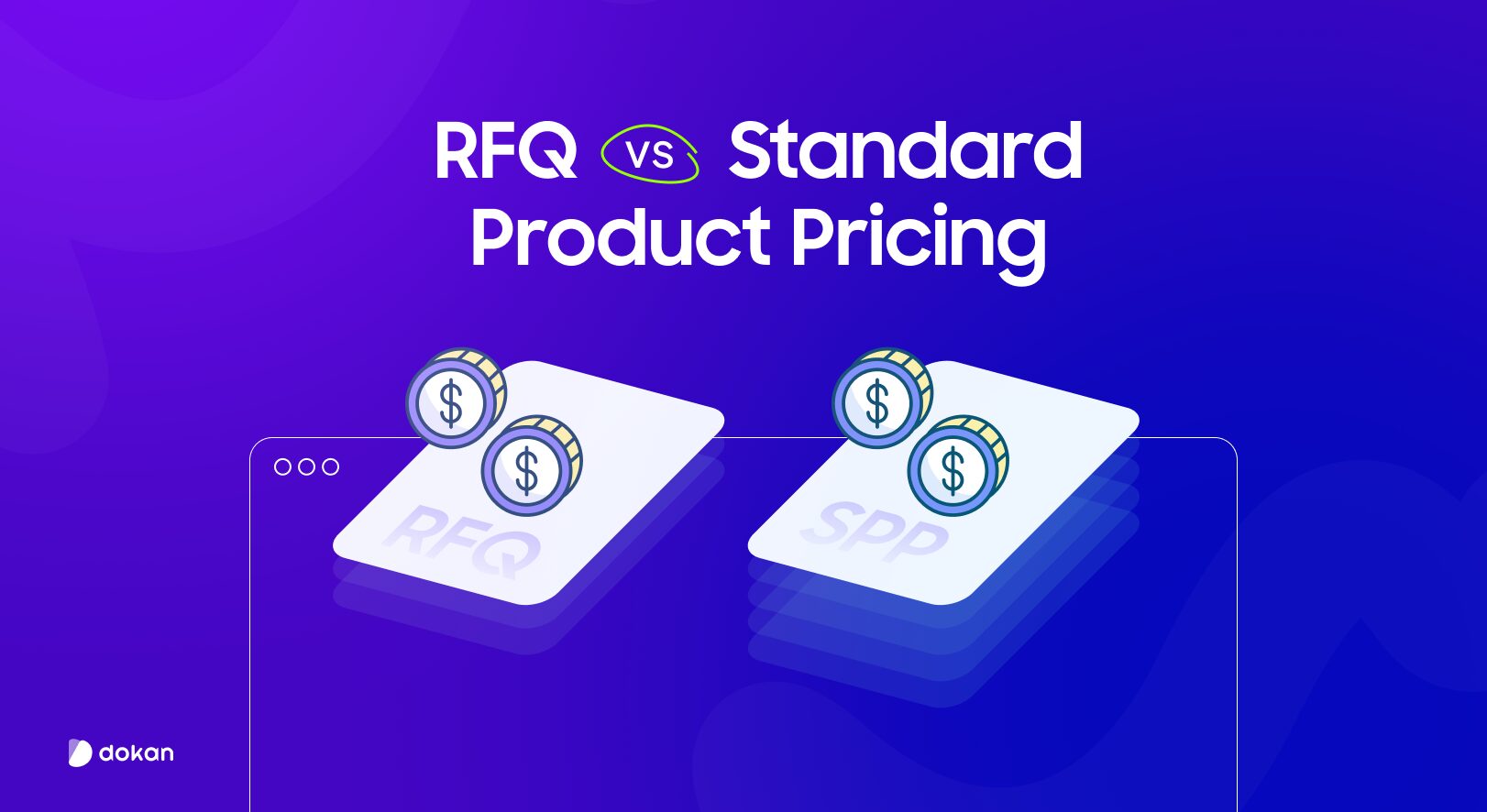When it comes to building an online store, you may get into a dilemma with Squarespace vs WordPress for eCommerce. Well, you are not alone!
Squarespace started its journey in January 2004. It is a popular website builder that offers a range of features specifically designed for eCommerce.
On the other hand, WordPress was founded by Matt Mullenweg in 2003 as a blogging platform. But using its vast library of useful plugins and themes you can easily create any online store without having any prior expertise.
So, which platform would be the best fit to build your eCommerce store?
In this article, we will compare Squarespace and WordPress across various aspects. Such as features, customization options, SEO capabilities, integrations, user experience, security, and support. It’ll help you make some concise decisions.
Squarespace vs WordPress: Short Overview
As you already know, Squarespace and WordPress are two popular website-building platforms, but they have different features and use cases.
Here’s a short overview of both platforms:
What is Squarespace?
Squarespace is a self-hosted platform that you can use to create and publish websites. This CMS platform is popular for its professional-looking templates, simplistic section-based editor, and powerful eCommerce features.
According to BuiltWith, 494,053 are built with Squarespace to sell their products, services, or content.
Squarespace offers a user-friendly interface and intuitive design tools for entrepreneurs to create full-fledged online stores. The platform provides ready-to-use templates with customization options. So you can easily modify the design considering your brand identity.

- Market share: 2.1% of CMS and 1.5 of all web
- The number of live sites: 3,033,248
- The number of sites in the top one million: 3209
- Most popular sites built with Squarespace: Lumio, Fotio, BigHuman, etc.
What is WordPress?
WordPress is the most popular web content management system. Using WordPress you can build any type of website easily without knowing any codes.
Around 6.7 million businesses use WordPress to run their online online stores.
Moreover, the rich library of WordPress plugins and themes lets you add a wide range of useful features and functions to your sites. In turn, it would be super flexible to make your site stand out from the crowd.
WordPress Usage Statistics

- Market share: 65% of CMS and 43% of all web
- The number of live sites: 34,770,646
- The number of sites in the top one million: 2,53,759
- Popular sites built with WordPress: Forbes, BBC America, Facebook, Bata, etc.
SaaS or Open Source? SaaS offers simplicity and support, while Open Source provides full control and endless customization. For more information, see our ultimate guide on SaaS vs Open Source eCommerce.
Squarespace vs WordPress for eCommerce: Key Features, Similarities & Differences
In this part, we’ll show you a detailed WordPress vs Squarespace comparison. So you can check and understand which platform offers the most benefit to a beginner-level user.
Today we’ll compare Squarespace vs WordPress for eCommerce based on below topics-
- Interface and Ease of Use
- Design and Personalization
- Shipping
- Tax
- Payment Gateways
- Security and Backup
- Product Management
- Marketing and SEO
- Help and Support
- Pricing
1. Interface and Ease of Use
During choosing an eCommerce platform the 2 questions come first into your mind-
- How easy it is to build an online store
- How easily do customers browse the store
Let’s explore the answers by comparing Squarespace vs WordPress for eCommerce in terms of ease of use & interface-
Squarespace
Squarespace provides an intuitive, drag-and-drop website builder with a user-friendly interface. This means you don’t need to have advanced technical skills to create your online store.
Moreover, you don’t need to worry about domain and hosting. Squarespace provides hosting. After designing your website you can publish it immediately and your store will be live on the internet. You can buy a suitable domain name from Squarespace or you can connect to a domain name that you already own.

To get started, go to their site and click on “Get Started”. It asks you some questions related to your brand so it can suggest you some templates from its vast library. Once you choose the template, it’s time to create an account on the site. After that, you can edit your template design to suit your requirements.
The onboarding process is very straightforward and it’ll give you detailed instructions in every step. So there is no chance to get confused.
On the other hand, Squarespace templates are designed with user experience in mind. It keeps the navigation system simple so customers can easily find the information they need.
WordPress
Let’s shift the spotlight to WordPress and discuss the features you’ll get while creating your online store. WordPress makes it easier for any type of user to create a website from a simple portfolio site to a fully functional eCommerce marketplace.
To get eCommerce facilities, you must install the WooCommerce plugin on your WordPress site. It requires only a few minutes and you have all the basic eCommerce functions instantly.
WooCommerce’s market share among eCommerce platforms is 25%. And the market share from the top 1 million eCommerce sites is 26%.
The initial setup process of WooCommerce is straightforward. WooCommerce offers a setup wizard that guides you through the basic configuration steps. The setup wizard includes many essential settings related to product pages, shopping cart, and checkout process.

WooCommerce provides you with all the tools and features needed to create a user-friendly online shopping experience. However, the final user experience largely depends on how well you design and optimize the website.
2. Design and Personalization
Hundreds of people are using the same platform to design their websites. But this doesn’t mean every website is looking the same. It is the power of customization. All the popular eCommerce builders offer you plenty of design options. Using them you can easily make your store stand out from the crowd.
Let’s show you what type of feature you’ll get to design your store inside Squarespace and WordPress-
Squarespace
Squarespace offers a wide range of professionally designed templates specifically designed for eCommerce. These templates are well-designed and mobile responsive. It ensures your store looks great on various devices, from mobile phones to desktop computers.

You can easily customize any chosen template by using a drag-and-drop editor. This means you can see how your website will look as you make changes. It gives you a visual and interactive editing experience.
Besides adding pages, Squarespace lets you add blocks to your website design. Squarespace has a bunch of blocks to choose from. Such as text, paragraph, form, newsletter, gallery, video, and many more. This approach simplifies the process of creating and updating pages.
WordPress
Selecting an appropriate WordPress theme that is compatible with WooCommerce is the first step. Most WordPress themes offer customization options through the WordPress Customizer. So, you can easily change colors, fonts, and layout elements without knowing any code.
Also, WooCommerce allows you to extend the functionality of your store with various plugins. For example, you can add plugins for social sharing, product reviews, and more.
There are more than 58,000 free plugins in the WordPress repository. Many of them also offer premium versions as well.
Moreover, many WordPress themes support page builders like Elementor, Beaver Builder, or Divi. These page builders provide a drag-and-drop interface for creating and customizing pages.
For more advanced customization, you can add custom CSS to modify the appearance of your store.
3. Shipping
Shipping is a crucial and integral component of eCommerce that impacts customer satisfaction, trust, and the overall success of your online store. Let’s discover the available shipping options inside Squarespace & WordPress-
Squarespace
Squarespace provides several built-in shipping options for eCommerce websites. Shipping options include-
- Flat rates
- Rates by weight
- Free shipping.
There is another shipping method called Carrier calculated. This option is only available on the Commerce Advanced and Premium plans and for domestic shipping within the United States.
You can create multiple shipping profiles and assign them to different products or groups of products.
WordPress
With WooCommerce, you’ll get 3 shipping options by default- Flat rate shipping, Free shipping, and Local pickup.

You can also add additional shipping options to WooCommerce using plugins or extensions. Some popular shipping options may include Carrier-calculated shipping, Real-time shipping, Table rate shipping, etc.
4. Tax
You need proper tax options for your online store. So you can maintain accurate records of tax collection. This is important for financial reporting, audits, and compliance with tax authorities. Failing to calculate tax accurately can lead to legal issues and penalties.
To avoid any further complexity, let’s show you how tax is calculated inside Squarespace and WordPress-
Squarespace
Squarespace offers the following tax options:
- Automatic tax rates: Squarespace can calculate sales tax automatically for you if you sell products in the United States. To do this, you’ll need to connect the TaxJar extension to your Squarespace account.
- Manual tax rates: You can manually enter tax rates for your products and services if you sell outside of the United States or if you do not want to use the TaxJar extension.
- Tax-inclusive pricing: You can choose to display your prices with tax included. As a result, customers will see the final price of their purchase, including tax, at checkout.
It is important to note that you are responsible for complying with all applicable tax laws. If you are unsure about how to set up taxes in Squarespace, you should consult with a tax professional.
WordPress
WooCommerce offers many tax options to facilitate its users. Such as Standard rate, Reduced rate, Zero rate, Compound tax, and Shipping tax.
You can also create custom tax rates and tax zones. Custom tax rates allow you to charge different tax rates on different products and services. Tax zones let you charge different tax rates to customers in different locations.
If you sell products and services to customers in multiple locations, you may need to create different tax zones. This will ensure that you are charging the correct tax rates to customers in each location.
You can also use plugins to manage taxes in your WooCommerce store. For example, some plugins can automatically calculate shipping rates and taxes based on the customer’s shipping address.
5. Payment Gateways
Payment gateways are a fundamental component of eCommerce. This attribute is directly connected to store revenue. On the other hand, shoppers are more likely to make purchases when they see recognizable and secure payment options.
Below you’ll find the available payment options for Squarespace vs WordPress for eCommerce-
Squarespace
Squarespace offers many popular payment gateways like Stripe and PayPal. Squarespace also supports-
- Apple Pay
- Google Pay
- Afterpay (available in the US, Canada, Australia, and New Zealand)
- Square (only for Squarespace point of sale in the Squarespace app)
- Clear pay (available in the UK and Australia)
Consider the payment methods that your customers want to use. If you sell products and services to customers in multiple countries, you should offer a variety of payment methods to accommodate them. With Squarespace, you can choose which payment gateways you want to offer to your customers and configure their settings.

Subscribe to
Dokan blog
WordPress
WooCommerce supports a wide range of payment gateways. It includes- Stripe, PayPal, Amazon Pay, Square, Authorize.net, Braintree, Klarna, Afterpay, Mollie, PayU, 2Checkout, Mercado Pago, etc.
You can also add additional payment gateways to WooCommerce using plugins and extensions.
Read more: A Comprehensive Guide on Top Payment Gateways for Your WooCommerce Store.
6. Security & Backup
Ecommerce sites collect and store sensitive customer information like personal details and payment information. Protecting this data is not only a legal requirement but also essential for maintaining customer trust.
Let’s check the available security features in Squarespace and WordPress below-
Squarespace
Squarespace takes security seriously and they offer several features to protect your eCommerce store. First of all, Squarespace automatically provides a free SSL certificate for every website. It encrypts data transmitted between your website and your visitors’ browsers.
On the other hand, Squarespace’s WAF helps protect your website from common web attacks like SQL injection and cross-site scripting. Another security feature of Squarespace is DDoS protection. Squarespace’s DDoS protection mitigates distributed denial-of-service attacks.
Moreover, Squarespace’s team of security experts monitors their network for threats 24/7. To ensure further security of your Squarespace eCommerce store, you can use strong passwords or enable two-factor authentication (2FA).
Another good thing is Squarespace automatically backs up your website regularly. However, it is a good idea to have backup copies of your website in case of a disaster.
WordPress
WordPress powers over 43% of all websites. The immense popularity of WordPress makes it an easy target for hackers and bots.
According to research conducted by Sucuri, “WordPress was the target of 90% of all hacking attempts on content management systems (CMS). Other CMSs didn’t even reach the 5% mark.”
To keep your WordPress eCommerce site secured you need to take some actions. Such as-
- Use a secure hosting provider: Choose a hosting provider that offers security features such as SSL certificates, firewalls, and malware scanning.
- Keep your WordPress core, themes, and plugins up to date: WordPress regularly releases security updates. It is important to keep your WordPress core, themes, and plugins up to date.
- Use strong passwords: Use strong and unique passwords for your WordPress admin account and any other accounts that are associated with your store.
- Enable two-factor authentication (2FA): 2FA adds an extra layer of security to your account. You need to enter a code from your phone in addition to your password when logging in.
- Install a security plugin: There are several security plugins available for WordPress. These plugins can provide additional security features such as login protection, malware scanning, and firewall protection.
It is also important to back up your WordPress eCommerce website on a regular basis. There are a number of WordPress backup plugins available that can automatically back up your website on a regular basis. You can also manually back up your WordPress website by downloading all of your website’s files and images to your computer.
Read more: 10 Effective Ways to Hacker-Proof Your WordPress Website.
7. Product & Order Management
Effective product management allows you to keep track of your inventory levels. You can monitor stock levels, set up alerts for low stock, and prevent over-selling. On the other hand, efficient order management streamlines the order fulfillment process. It helps you process and ship orders quickly.
Both Squarespace and WordPress support individual product & order Management systems. Let’s discover what they offer for their users-
Squarespace
Squarespace lets you add, edit, and delete products from your store. You can also add product variants, such as different sizes and colors. Squarespace Commerce also provides features for managing product inventory, images, and descriptions.

To manage customers’ orders efficiently, you can view and manage all of your orders. It gives you the flexibility to see the status of each order, the products that were ordered, and the customer information. Squarespace Commerce also provides features for processing orders, shipping orders, and refunding orders.
In addition to these features, there are a number of third-party extensions that can extend the functionality of Squarespace Commerce’s product and order management system. Here are a few examples:
- Printful: This extension allows you to print and ship products directly from Printful to your customers.
- ShipStation: This extension helps you to ship orders more efficiently by automating tasks such as shipping label generation and tracking.
- AfterShip: This extension provides you with real-time tracking information for your shipments.
By using Squarespace Commerce and its extensions, you can create a comprehensive product and order management system for your eCommerce.
WordPress
WooCommerce provides a number of features for managing products and orders.
WooCommerce allows you to add, edit, and delete products from your store. You can also add product variations, such as different sizes and colors. WooCommerce also provides features for managing product inventory, images, and descriptions.

Not only these, WooCommerce allows you to view and manage all of your orders. You can see the status of each order, the products that were ordered, and the customer information. WooCommerce also provides features for processing orders, shipping orders, and refunding orders.
There are also a number of plugins that can extend the functionality of WooCommerce’s product and order management system. For example, you can use WooCommerce Product Add-Ons to add custom product add-ons to your products, such as gift wrapping or personalized messages.
8. Marketing & SEO
Having great products in your store is not enough to get customers. You have to tell people about it. A strong online presence can help you in this manner. Besides unique promotions and copies, there are many basic and recurring tasks where eCommerce platforms can simplify your tasks.
Let’s show you how Squarespace and WordPress can help you in terms of marketing & SEO-
Squarespace
Squarespace Commerce provides a number of marketing and SEO tools to promote your eCommerce store and reach more customers.
For example, Squarespace Commerce integrates with a number of email marketing providers. Such as MailChimp and Constant Contact. This allows you to send email newsletters to your customers with promotions, new product announcements, and other updates.

For social media marketing, Squarespace makes it easy to connect your store to your social media accounts. You can also do paid advertising inside Squarespace Commerce as it supports Google Ads and Facebook Ads.
As you know, for an eCommerce store you have to optimize every product page and category. Squarespace Commerce automatically generates SEO-friendly URLs for your products and pages. Moreover, Squarespace Commerce provides a number of built-in SEO tools, such as an XML sitemap generator and a robots.txt editor.
In addition to these features, there are a number of third-party extensions that can extend the marketing and SEO functionality of Squarespace Commerce, such as Yotpo, All in One SEO Pack, Social Proofo, etc.
WordPress
WooCommerce allows you to create clean, SEO-friendly URLs for product pages, categories, and tags. You can also set custom SEO titles and meta descriptions for individual product pages and categories. These meta tags are essential for search engine optimization and can improve click-through rates in search engine results pages.
WooCommerce can automatically generate XML sitemaps. It also has schema.org integration. So you can mark up your product data with structured data.
Another important thing is, with WooCommerce you can easily create and manage coupons and discounts for your customers. To build trust and credibility you can use WooCommerce product review.
While WooCommerce offers many built-in marketing and SEO features, you may also want to consider additional SEO plugins and marketing tools to further enhance your online store’s performance and visibility. For example, Yoast SEO, Rank Math, etc.
9. Help and Support
Creating an online store is an ongoing process. You may require help at any stage. That’s why it’s important to check about the support process before choosing any eCommerce platform.
Squarespace
Squarespace’s Knowledge Base contains a vast library of articles and tutorials that can help you with everything from getting started with Squarespace to creating and managing your website.
They also offer a number of video tutorials that can walk you through specific tasks. Such as how to add a blog to your website or how to connect your domain name to Squarespace.
For getting help you can check their Community Forum as well. There you can ask questions and get help from other Squarespace users.
Squarespace offers customer support via live chat, email, and phone.
WordPress
WooCommerce’s documentation contains a comprehensive overview of all the features and functionality of the plugin. There you’ll find a number of code snippets that can be used to extend the functionality of WooCommerce.
WooCommerce has a number of support forums where you can ask questions and get help from other WooCommerce users.
WooCommerce offers customer support via email and phone.
10. Pricing
Every business has a business budget. Besides the eCommerce platform, you have a lot of things to do and spend. So, it’s crucial to check whether the cost of an eCommerce platform fits your budget or not.
Squarespace
Squarespace offers four pricing plans for its eCommerce platform:
- Personal: $16 per month
- Business: $23 per month
- Basic Commerce: $27 per month
- Advanced Commerce: $49 per month
All Squarespace plans include a custom domain name, unlimited storage and bandwidth, and 24/7 customer support. The Commerce plans include features such as abandoned cart recovery, real-time shipping rates, and gift cards.
WordPress
WooCommerce is a free plugin for WordPress. However, you will need to purchase a domain name and web hosting in order to use WooCommerce. You may also want to purchase additional plugins and themes to extend the functionality of your WooCommerce store.
The cost of web hosting varies depending on the provider and the features you need. Your initial costs may include-
- Domain name (about $12/year)
- A hosting service(from $5 – $25/month) and
- A Secure Socket Layer Certificate (SSL – about $5/year).
The cost of plugins and themes also varies depending on the plugin or theme you select. For your growing business, you may need to spend around $100 per year for premium plugins and themes.

A Quick Comparison of Squarespace vs WordPress for eCommerce
Below you’ll find a comparison table of Squarespace vs WordPress for eCommerce. Have a close look at this-
| Category | Squarespace | WordPress |
| Ease of use | User-friendly with a visual, drag-and-drop builder. Ideal for beginners. | Squarespace provides support as part of its package. Such as live chat, email, and phone calls. |
| Cost | Monthly subscription fees that include hosting. | Open-source and free. But you need to pay for hosting and premium plugins/themes. |
| Customization | Limited in terms of advanced customization, especially for complex needs. | Highly customizable with a vast selection of themes and plugins. |
| eCommerce Features | Good for small to medium-sized online stores. | Versatile and can handle a wide range of eCommerce requirements. |
| SEO | Basic SEO features are available. | Strong SEO capabilities with plugins like Yoast SEO. |
| Security | Good security features with SSL certificates and DDoS protection. | Ensures strong security with the help of essential plugins |
| Support | Squarespace provides support as part of its package. Such as live chat, email, and phone call. | Support options include community forums, paid support, and third-party services. |
| Blogging | Basic blogging features are available. | Strong blogging capabilities with built-in Gutenberg editor. |
| Multilingual | Limited multilingual support. | Many translation and multilingual plugins are available. |
| Performance | Squarespace offers good performance and fast loading times. | Performance can vary depending on hosting and optimization. |
| Scalability | Limited scalability for larger and more complex stores. | Highly scalable, it would be suitable for growing businesses. |
| Developer tools | Limited developer tools for advanced customization. | Extensive developer tools and documentation. |
| Good for | Small to medium-sized online stores, artists, and creatives. | Businesses of all sizes, especially those with complex needs and technical expertise. |
| Limitations | Limited customizability and scalability for larger stores. | Requires more technical knowledge and management. |
| Multivendor Support | Not natively supported, may require third-party plugins. | Supported with plugins and platforms like Dokan Multivendor. |
So, what do you think, which one will be perfect WordPress or Squarespace for eCommerce?
Wrapping Up on Squarespace vs WordPress for eCommerce
eCommerce platforms are designed to help users regardless of technical expertise to set up and manage an online store. But there are a lot of options to choose from. In this post, we compare Squarespace vs WordPress for eCommerce considering different aspects of each platform.
Both platforms are effective eCommerce solutions. The decision between Squarespace and WordPress ultimately depends on the unique characteristics and aspirations of your business.
If you’re looking for a simple and user-friendly solution for a smaller or less complex online store, Squarespace might be the better choice. However, if you require extensive customization and scalability, WordPress with the right hosting and plugins could be the way to go.
So, which platform you’re going to pick for your online store? Do share your thoughts with us in the comment section below.
Check more popular comparison posts on WordPress Vs other eCommerce platforms-
Subscribe to
Dokan blog
We send weekly newsletters, no spam for sure!







Leave a Reply